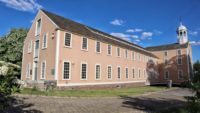Ram V. Sutar, an 89-year-old sculptor known for designing scores of large monuments in his native India, is observing construction on two statues in the western part of the country to honor a pair of historical figures. Besides making a political statement, the works are intended to “commemorate the icons and enhance tourism,” he said.
Both statues, when completed, will stand among the tallest in the world. As planned at present, there is a difference in height of around 10 meters between the two. However, an engineer hinted that this detail could likely change. “The challenge is to give each statue a lasting memory," he said. "These are two legends and there are sentiments attached to each. One cannot be taller than another.”
Prime Minister Narendra Modi hails from the state of Gujarat, dedicated to independence and freedom fighter Sardar Vallabhai Patel, the Iron Man of India. His monument, the Statue of Unity, is being undertaken by a consortium of Turner Project Management India Pvt Ltd as lead member. Meinhardt India Pvt Ltd, Michael Graves & Associates Inc. is providing design, engineering, project management and construction management services while the management team of SSNNL (Sardar Sarovar Narmada Nigam Ltd) will implement the project
Many of the consortium members have worked on some of the world's tallest structures, including the Burj Khalifa in Dubai. Larsen & Tourbo, Indian’s largest engineering and construction company, is responsible for project design, engineering, procurement, construction, operation, and maintenance.
The project, expected to cost around $400 million, is sited in a drained riverbed that will support the base of the 182-m-high statue, which is designed to withstand wind velocity up to 60 m per sec. Once the statue is completed, the Sardar Sarovar Dam will release water from the Narbada river to create the island, said a statement.
The Statue of Unity consists of two semi-joined, composite concrete cylindrical cores, surrounded by a structural steel space frame to support the exterior cladding, Construction started in 2014 and is scheduled is to be completed by 2018.
The second statue, not yet named, will depict the 17th century Hindu warrior king Shivaji. A fierce battlefield technician, he defeated forces of a sultanate in decline and established the basis of the Maratha Empire, a touchstone of Hindu nationalists today. The structure will be installed on a patch of rock spread over 16 hectares in the Arabian Sea, off the Mumbai coast.
Egis India Consulting Engineers Pvt Ltd, proof consultants to the Unity statue, and project management consultants for the 192-m-high Shivaji statue, will finalize the design, material, cost and project delivery method. The state government plans to float civil tenders by inviting international competitive bidding by the end of the month. While the project cost is pegged at around $350 million, a project management official not associated with it, told ENR: “It is a tough project. It is likely the cost could hit around $900 million by the time it is over.”
Egis Chairman Nicolas Jachiet acknowledged the job would face difficulties. “Even without the statue, it is a challenge,” he told ENR. Constructing an artificial island close to a major city such as Mumbai will require “a host of technical skills,” he said. “Technically, the height of the statue is a challenge and our task will be to review the design made by the contractor,” he added. The base of the statue is 85 ft high. The first phase comprising 7 hectares is scheduled for completion by December 2019.
Sutar has not yet decided “whether [the warrior king’s facial expression] should be combative or benevolent,” Ashish Tandon, CEO, Egis India told ENR. Asked if the timeline would be met, he said: “the Statue of Liberty was not completed in two years.” The two statues are different from all his earlier works, Sutar told ENR. In the past, he has used a combination of 85% bronze, 5% each of zinc and lead. “Now the two statues, made of steel structures and concrete pillars, will have 88% bronze, 8% copper, and 4% each of tin, and zinc. The harder materials will sustain wind pressure.”
The Shivaji design has the man on a horse with bent hind legs brandishing a sword. “It will be welded together in five parts. The entire weight will be transferred to the ground. Two concrete cores will go from the legs to the chest.” The statue will be made in a Chinese foundry. “The skin has not been welded through, like shingles on roof with each successive course overlapping the joints below,” said Sutar.




